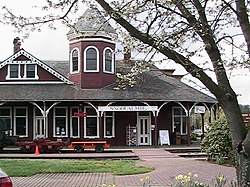Snoqualmie, Washington
- This article refers to the city of Snoqualmie, Washington. For the Native American tribe, see Snoqualmie (tribe). For the river, see Snoqualmie River.
City of Snoqualmie, Washington | |
|---|---|
 Snoqualmie Depot | |
 Location of Snoqualmie within King County. | |
| Country | United States |
| State | Washington |
| County | King |
| Government | |
| • Mayor | Matt Larson |
| Population (2000) | |
| • Total | 1,631 |
| Time zone | UTC-8 (PST) |
| • Summer (DST) | UTC-7 (PDT) |
| Website | http://www.ci.snoqualmie.wa.us/ |
Snoqualmie (IPA: [sno kwal mi]) is a city next to Snoqualmie Falls in King County, Washington. The city is home to the Northwest Railway Museum. As of the United States 2000 Census, the city population was 1,631. Movie actress Ella Raines was born in Snoqualmie Falls, a mill town across the Snoqualmie River that is now part of Snoqualmie, on 6 August 1920. David Lynch's series Twin Peaks was filmed in Snoqualmie and in the neighboring town of North Bend.
According to Washington State population estimates[1], Snoqualmie grew to 6,345 or 289.03% between 2000 and 2005, ranking it 1st of 281 in population growth in Washington State. The 2006 estimate was 7,815. This growth is out of control and needs to be stopped before the town is overrun like issaquah.
History
Snoqualmie was officially incorporated on June 9, 1903. Several historic buildings including City Hall and the railroad station line the downtown core.
Geography
Snoqualmie is located at 47°31′59″N 121°50′40″W / 47.53306°N 121.84444°W (47.532934, -121.844341)Template:GR.
The city is at an elevation of 124 m (410 ft) above MSL.
According to the United States Census Bureau, the city has a total area of 13.4 km² (5.2 mi²). 13.3 km² (5.1 mi²) of it is land and 0.1 km² (0.04 mi²) of it (0.58%) is water.
Economy
Until recently, logging and Weyerhaeuser's milling operations were the mainstays of the local economy. Since 1989, the company has run a much smaller mill operation. While dairies were a significant local industry into the early 1950s, agriculture is no longer a major economic force in the community. With the completion of Interstate 90 in the 1970s, Snoqualmie became more accessible to Seattle and the Eastside, resulting in more residents working in the communities to the West. In addition, the Snoqualmie Ridge Business Park now employs close to a thousand people, and continues to expand.
Currently, the City's scenic and recreational attractions are fostering the growth of a significant local tourism economy. Along with the Falls, the city is home to the Northwest Railway Museum. The Museum owns a historic depot and operates a historic tourist railway in the city.
Demographics

As of the United States 2000 CensusTemplate:GR, there were 1,631 people, 632 households, and 432 families residing in the city. The population density was 122.5/km² (317.2/mi²). There were 656 housing units at an average density of 49.3/km² (127.6/mi²). The racial makeup of the city was 89.88% White, 0.86% African American, 2.58% Native American, 1.90% Asian, 0.06% Pacific Islander, 1.78% from other races, and 2.94% from two or more races. Hispanic or Latino of any race were 5.21% of the population.
There were 632 households out of which 38.8% had children under the age of 18 living with them, 48.4% were married couples living together, 14.1% had a female householder with no husband present, and 31.6% were non-families. 25.2% of all households were made up of individuals and 4.7% had someone living alone who was 65 years of age or older. The average household size was 2.58 and the average family size was 3.06.
In the city the population was spread out with 28.9% under the age of 18, 7.9% from 18 to 24, 39.3% from 25 to 44, 17.7% from 45 to 64, and 6.2% who were 65 years of age or older. The median age was 32 years. For every 100 females there were 101.1 males. For every 100 females age 18 and over, there were 99.8 males.
The median income for a household in the city was US$52,697, and the median income for a family was US$58,889. Males had a median income of US$40,645 versus US$30,917 for females. The per capita income for the city was US$22,239. About 6.1% of families and 9.4% of the population were below the poverty line, including 16.9% of those under age 18 and 1.7% of those age 65 or over.
External links
- Official web site
- Snoqualmie Ridge Neighborhood Site
- Snoqualmie Valley Record, The name Snoqualmie
- Factual Information from www.city-data.com
- Hiking in the Snoqualmie area
- Nearby hiking trails on Hikipedia
- InTwinPeaks.com –Photos of theTwin Peaks filming locations in Snoqualmie, then and now
